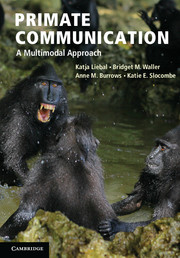Book contents
- Frontmatter
- Contents
- Preface
- Acknowledgements
- Part I Introduction to primate communication
- Part II Approaches to primate communication
- Part III Cognitive characteristics of primate communication
- 6 Acquisition
- 7 Flexibility
- 8 Intentionality
- 9 Referentiality
- Part IV Approaches to the evolution of primate communication
- Glossary
- References
- Species index
- Subject index
8 - Intentionality
Published online by Cambridge University Press: 05 December 2013
- Frontmatter
- Contents
- Preface
- Acknowledgements
- Part I Introduction to primate communication
- Part II Approaches to primate communication
- Part III Cognitive characteristics of primate communication
- 6 Acquisition
- 7 Flexibility
- 8 Intentionality
- 9 Referentiality
- Part IV Approaches to the evolution of primate communication
- Glossary
- References
- Species index
- Subject index
Summary
Intentionality is a key feature of human language. Much attention has therefore been dedicated to the communication of nonhuman primates to assess whether they also use their signals intentionally. The purpose of this chapter is to introduce the criteria scientists have used to identify intentional communication in primates and review the extent to which these criteria have been met for each of the different modalities. We then evaluate the validity of these criteria and discuss how different studies define and identify intentional communication inconsistently. Based on this, we propose a tentative set of criteria that may be most appropriate for identifying intentional communication across modalities and for multimodal signals.
What is intentional communication?
The question of what intentional behaviour actually is, and the extent to which the concept is relevant to communication, is hotly debated, and could easily constitute an entire book on its own. In philosophy, intentionality is often seen as the crucial characteristic that differentiates mental from non-mental states (Brentano, 1874 [1973]). Unlike non-mental states, mental states – including communicative acts – are ‘about’ certain objects and/or states of affairs in the world (Benga, 2005). Because of this, intentionality is often simply described as ‘aboutness’ (Dennett, 1983, 1987). For a mental state to be about the world is for it to have an intentional content, where this content is a way of representing the object or state to which the mental state is directed. A large philosophical literature has been devoted to considering what it is to have content, and to the varieties of content that minds might have (e.g. Cussins, 1992; Dennett, 1987; McDowell, 1994).
- Type
- Chapter
- Information
- Primate CommunicationA Multimodal Approach, pp. 169 - 193Publisher: Cambridge University PressPrint publication year: 2013



